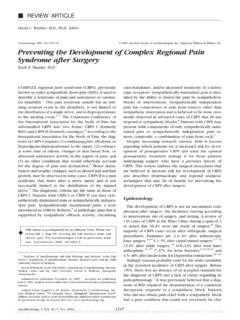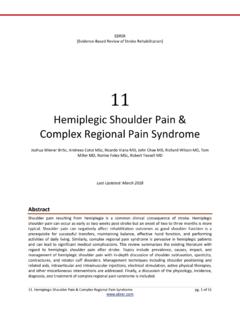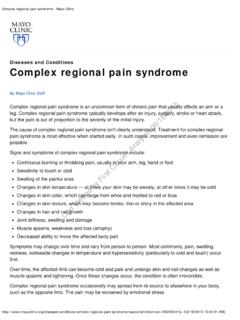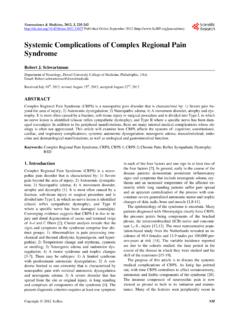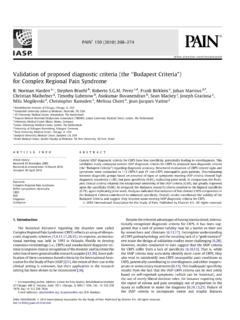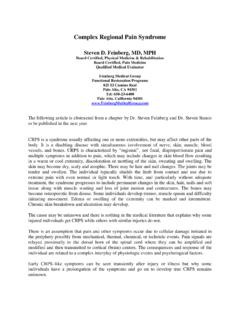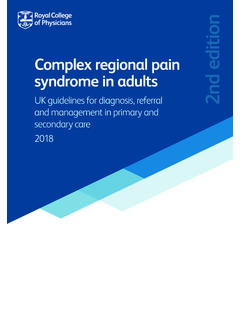Transcription of SPREAD OF COMPLEX REGIONAL PAIN SYNDROME(CRPS) H ...
1 1 SPREAD OF COMPLEX REGIONAL pain SYNDROME(CRPS) H. Hooshmand, and Eric M. Phillips Neurological Associates pain Management Center Vero Beach, FloridaAbstract. COMPLEX REGIONAL pain syndrome ( crps ) is usually caused by a minor injury, and requiresproper evaluation and multi-disciplinary treatment addressing the multifaceted pathological processes that evolveduring its chronic course. Patient s age, the nature of pathology, and mode of therapy influence the outcome oftreatment. If at all possible, surgery, ice and cast applications should be avoided.
2 There is a desperate need forresearch in proper management of COMPLEX REGIONAL pain syndrome ( crps ), internal organs, SPREAD , surgery, sympatheticallyindependent pain (SIP), sympathetically maintained pain (SMP).INTRODUCTIONThe SPREAD of COMPLEX REGIONAL pain syndrome ( crps ) in vertical or horizontal fashion (upper and lowerextremities, or both upper or both lower extremities) has been recognized ever since 1976 (1). The surgical procedurefacilitates the SPREAD of the crps (2). More recently, the phenomenon of the SPREAD of the disease has been proven bySchwartzman, et al (3,4).
3 The chain of sympathetic ganglia from base of the skull to sacral regions on the right and leftsides, SPREAD the pathologic impulse to other extremities (5). The phenomenon of referred pain should not be mistaken for SPREAD of the is a disease of stress - be it psychological or physical - affecting the sympathetic nervous system. Thissystem is bilaterally innervated. The bilateral innervation is due to the fact that at the level of spinal cord, thethermoregulation originates from the periaqueductal gray matter of the spinal cord and influences the sympatheticfunction on both right and left extremities (6,7,8).
4 Immersion of one hand or one foot in a bucket of ice water, after lessthan one minute, results in marked hypothermia of the contralateral extremity (1,8). With passage of time, the samephenomenon leads to bilateral pain and hypothermia, and a full scale picture of SPREAD of the OF COMPLEX REGIONAL pain SYNDROME(CRPS) crps is not usually limited to one part of an extremity or one extremity. Usually, the pathological sympatheticfunction spreads to adjacent areas (5). The first areas becoming involved are the pathway of the sympathetic nerves between the end organ ( , footor hand) and the spinal cord.
5 This results in an inflammation and irritation of the nerves all the way from the end organto the spinal cord. This is manifested by muscle spasm in the cervical and lumbar spine region, secondary back and neckpain, headache, dizziness, and tinnitus (buzzing in the ears). In the path of the areas of inflammation, the posterior sensory nerve branches corresponding to the level of theinvolved nerves and secretes substance P (a painful substance half the molecule of endorphine and practically identicalto jalopena pepper extract). This secretion of substance P under the skin in the paraspinal regions can be identified byexerting equal pressure on the two sides of the vertebra, and observing the so-called "red reflex"(Figure 1).
6 Pressure onthe normal areas causes no reddish discoloration. On the other hand, pressure on the areas of sensory nerve irritationcauses a reddish discoloration of the skin which is accompanied by Travaill's Jump Sign. This area of reddish2discoloration can be easily blocked and dissipated by injection of local anesthetic such as Marcaine and if the conditionis chronic and severe, one can add a small amount of Celestone or Depo - Medrol to it. This nerve block providesexcellent relief of pain and reversal of constriction of the blood 1.
7 Cervical neuropathic pain represented with hypothermia on ITI in the paravertebral pressure exerted over the cervical spine (Left) revealed reactive release of inflammatorychemicals and blushing of the skin in the hypothermic area. Treatment with paravertebral nerveblocks (Right) provides pain relief, and dissemination of irritative substances P. Massage therapyafter paravertebral nerve blocks provide a longer lasting relief for the patient. Another area of involvement of crps is the spinal cord itself. This is manifested by movement disorder, musclespasm, weakness of the extremity, as well as urgency and frequency of urination and disturbance of erection.
8 Invasive procedures such as the insertion of a spinal cord stimulator (SCS) can flare-up such an involvementof the spinal cord and it can cause "idiopathic paralysis" due to flare-up and constriction of blood vessels to the spinalcord. The same can be noted in rare cases of insertion of a catheter for sympathetic nerve blocks in the paravertebral orepidural regions. In the visceral involvement of crps the skin is usually cold and the deep structures are hot and have anexaggerated blood circulation. This results in osteoporosis, fracture of the bones, areas of swelling and fluid formationbetween the bones and joints identified on MRI, and severe pain as well as weakness in the deep structures.
9 This causesa high risk of amputation for the patient. Amputation is totally unnecessary and should never be performed. Just simpleweight bearing under the effect of a strong analgesic such as Stadol or Buprenorphine (Buprenex) along with the use ofmoist, warm water and epsom salt, exercise and massage for the extremity to reverse the vasoconstriction on the surfaceand to increase the circulation in the deep structures corrects this situation without the need for amputation. Amputationin crps is a slow, painful, gradual suicide. The next structures being involved in some cases of crps are the blood vessels to the kidney with resultantepisodes of sudden brief and temporary bleeding through the kidney accompanied by a marked elevation of bloodpressure.
10 The same principle can cause attacks of nose bleeds, severe headache, dizziness, passing out spells as of Clonodine Patch in the area of the kidney in the flank (in the back) usually results in good relief of suchspasm and inflammation of the blood vessels. The patient should be treated with Dibenzyline or Hytrin which are lifesaving in such patients. 3 The involvement of other sympathetic midline connections and plexi such as celiac (abdominal pain , pepticulcer, nausea, vomiting, and weight loss), superior and inferior mesenteric plexi (diarrhea, abdominal cramps, and weightloss), and cardiac plexus (chest pain , abnormal heart beat, tachycardia, and heart attack), and carotid and vertebral plexi(severe vascular headaches, dizziness, tinnitus, attacks of falling spells, and syncopal attacks)
